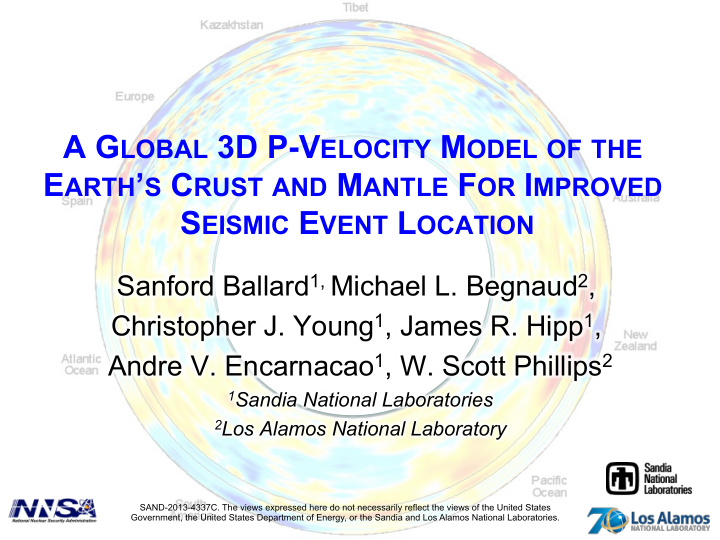



A G LOBAL 3D P-V ELOCITY M ODEL OF THE E ARTH ’ S C RUST AND M ANTLE F OR I MPROVED S EISMIC E VENT L OCATION Sanford Ballard 1, Michael L. Begnaud 2 , Christopher J. Young 1 , James R. Hipp 1 , Andre V. Encarnacao 1 , W. Scott Phillips 2 1 Sandia National Laboratories 2 Los Alamos National Laboratory SAND-2013-4337C. The views expressed here do not necessarily reflect the views of the United States Government, the United States Department of Energy, or the Sandia and Los Alamos National Laboratories.
Introduction • Monitoring the Comprehensive Nuclear-Test-Ban SALSA3D Treaty requires the ability to quickly locate small seismic events anywhere on the Earth with great accuracy and precision. • This requires the ability to accurately predict the travel time of seismic energy from source to receiver, at local, regional and teleseismic distances. • The accuracy and precision of travel time prediction is directly related to the fidelity of the Earth models used to make the predictions. • To date, monitoring agencies have used 1D and 2 ½ D Earth models for travel time prediction, which cannot match the accuracy and precision of full 3D Earth models. • In this study, we have developed a full 3D velocity model of the Earth’s crust and mantle with the single-minded goal of improving the accuracy and precision of seismic event locations. • Included with our model is software that meets demanding computational requirements.
Outline SALSA3D § Tomography § Data § Results § Validation § Travel time residuals § Test events § Model Uncertainty § Model covariance matrix § Path dependent travel time uncertainty
Data Ground Truth (GT) 25 km or better ( Bondár et al., 2004 ) ¡ ¡ ¡ ¡ ¡ ¡ ¡ ¡ ¡ ¡ ¡ ¡122K ¡events ¡ ¡ ¡ ¡ ¡ ¡ ¡ ¡ ¡ ¡ ¡ ¡ ¡ ¡ ¡ ¡ ¡13K ¡sta,ons ¡ ¡ ¡ ¡ ¡ ¡ ¡ ¡ ¡ ¡ ¡ ¡ ¡ ¡ ¡ ¡ ¡ ¡ ¡ ¡ ¡10M ¡ray ¡paths ¡
Model Resolution Adaptive Gridding Grids are constructed and managed using GeoTess open source software www.sandia.gov/geotess
SALSA3D
SALSA3D
Residual Reduction SALSA3D reduced the median bias by 73% compared to ak135 Count
Validation and Model Comparison ak135 RSTT / ak135 SALSA3D
Generation of Random Realizations For each validation event, randomly select many subsets of the available P and Pn arrivals Stations: Regional (Pn) Teleseismic (P) Example 10 Pn, 5 P 20 30 x 63 = 1890 possible realizations 15 Number of P 10 Event Event Event 5 0 0 10 20 Number of Pn
Mislocation Grids SALSA3D-ak135 RSTT-ak135 SALSA3D-RSTT � Difference (km) 0 ��
Event Mislocation Comparisons SALSA3D vs. ak135 RSTT vs. ak135 SALSA3D vs. RSTT Median Misloc: SALSA3D (km) Median Misloc: SALSA3D (km) Median Misloc: RSTT (km) Median Misloc: AK135 (km) Median Misloc: AK135 (km) Median Misloc: RSTT (km)
Deep Seismic Sounding (DSS) Lines
Travel Time Difference from AK135 Station-phase specific travel times stored in 3D lookup tables using open source GeoTess software (www.sandia.gov/geotess)
Uncertainty Basic Tomography Equation 1 1 C − 0 A C − 0 d ⎡ ⎤ ⎡ ⎤ ⎡Δ 2 2 ⎡ ⎤ ⎤ d d s 0 Δ = 0 ⎢ ⎥ ⎢ ⎥ ⎢ ⎥ ⎢ ⎥ 1 1 0 C − I 0 C − 0 2 2 ⎢ ⎥ ⎣ ⎦ ⎢ ⎥ ⎣ ⎦ ⎣ ⎦ ⎣ ⎦ s s 0 0 Uncertainty of the P Wave Velocity in the Mantle − 1 + A T C d 0 − 1 " $ − 1 A C M = C s 0 # % Travel Time Uncertainty for a Single Ray Through the Earth 2 = ∫∫ C M dx σ tt path
Travel Time Prediction Uncertainty Station-phase specific uncertainty stored in 3D lookup tables using open source GeoTess software (www.sandia.gov/geotess)
Conclusions § Monitoring the Comprehensive Nuclear-Test-Ban Treaty requires the ability to quickly locate small seismic events anywhere on the Earth with great accuracy and precision. § SALSA3D is a 3D multi-resolution model of the compressional wave speed in the Earth constructed with the goal of improving the accuracy and precision of seismic event location. § Unambiguous improvement in travel-time prediction and event location compared to ak135 and RSTT/ak135, especially for events observed by a network of stations that is small or has poor geometry. § Path dependent travel time prediction uncertainties calculated using the full model covariance matrix provide realistic estimates of model uncertainty. § Station-phase specific travel time predictions and uncertainties are pre- calculated for a network and stored in 3D lookup tables. Retrieval is fast and accurate using open source GeoTess software (www.sandia.gov/geotess).
References Bondár, I., Myers, S. C., Engdahl, E. R. and Bergman, E. A. (2004), Epicentre accuracy based on seismic network criteria. Geophysical Journal International, 156: 483–496, http://dx.doi.org/10.1111/j.1365-246X.2004.02070.x
Recommend
More recommend